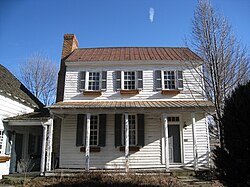Wilson-Wodrow-Mytinger House | |
 The clerk's office (1780s) of the Wilson-Wodrow-Mytinger House | |
| Location | 51 West Gravel Lane Romney, West Virginia, United States[2] |
|---|---|
| Coordinates | 39°20′29″N 78°45′27″W / 39.34139°N 78.75750°W |
| Area | 1 acre (0.40 ha) |
| Built | (c. 1740s–c. 1780s)[3] Kitchen structure (c. 1750) Clerk's office (1780s) |
| Architectural style | American colonial architecture |
| NRHP reference No. | 77001375[1] |
| Designated | August 22, 1977[1] |
The Wilson-Wodrow-Mytinger House is a complex of three structures, built between the 1740s and 1780s, in Romney, West Virginia. The clerk's office, dating from the 1780s, is the oldest surviving public office building in West Virginia. The kitchen building (c. 1750) is the oldest remaining component of the Wilson-Wodrow-Mytinger House and the oldest building in Romney. Throughout its history, the Wilson-Wodrow-Mytinger House has been known as the Andrew Wodrow House, the Mytinger Family Home, and the Mytinger House.[2][3]
The earliest person recorded residing on Lot Number 48 in Romney was Hugh Murphy. In 1763, Colonel George William Wilson received a patent to Lot Number 48 from Thomas Fairfax, 6th Lord Fairfax of Cameron, to purchase the lot from Murphy. Wilson served in the Hampshire County militia as a major during the French and Indian War. He relocated to Pennsylvania, and in 1770, George Washington spent the night in a log cabin on the northeastern corner of Lot Number 48. Andrew Wodrow arrived in Hampshire County near or after the end of the American Revolutionary War. In 1782, Wodrow became clerk of court for Hampshire County. He completed the clerk's office building in the 1780s, and the complex assumed its current configuration by 1790.
Wodrow served as Clerk of Court for Hampshire County until his death in 1814, after which ownership passed to Wodrow's son-in-law, John McDowell; a Dr. McClinoch; and the Mytinger family, who retained the property for about 100 years. Manning H. Williams purchased the house and restored it in 1962. Dr. Herbert P. Stelling purchased the Wilson-Wodrow-Mytinger House in 1973, and it opened as a museum and an arts and handicrafts shop known as Colonial Craftsmen. While under the Stelling family's ownership, the house was listed on the National Register of Historic Places in 1977. Its current owners, Old Hampshire Ltd., purchased the Wilson-Wodrow-Mytinger House in 1985.
- ^ a b "National Register Information System – Wilson-Wodrow-Mytinger House (#77001375)". National Register of Historic Places. National Park Service. November 2, 2013. Retrieved February 20, 2018.
- ^ a b Pitts & Harding 1976, p. 1 of the PDF.
- ^ a b Munske & Kerns 2004, p. 81.



